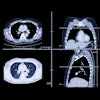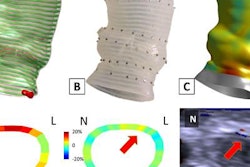
CT detects small clots surrounding valve leaflets after transcatheter aortic valve replacement (TAVR) that are missed on echocardiography studies, concludes new research presented at the just-concluded American College of Cardiology (ACC) meeting in Washington, DC. Reduced valve motion after the procedure may be a sign of the condition, the researchers said.
The group from the University of California, Los Angeles analyzed CT scans and other health records from 850 patients enrolled in two medical registries. The patients received scans three months after TAVR or surgical aortic valve replacement (SAVR), two procedures used to replace a patient's faulty aortic valve with an artificial one.
Analysis of CT scans revealed subclinical leaflet thrombosis in 13.6% of TAVR patients and 3.8% of SAVR patients, for an overall rate of 12.1% among all patients. The lower rate of thrombosis among SAVR patients may simply reflect that they were generally younger and healthier than TAVR patients, the researchers noted.
"This phenomenon of subclinical leaflet thrombosis can be missed if you just use transthoracic echocardiogram," said lead author Dr. Raj Makkar, an associate director at Cedars-Sinai Heart Institute in Los Angeles, in a statement. "Based on our study, CT is clearly a more sensitive and appropriate technique to actually make a diagnosis of subclinical leaflet thrombosis."
The study is one of the largest to date to investigate thrombosis as a potential cause of reduced valve motion after aortic valve replacement. The results confirm an earlier study suggesting that blood clots are detectable with CT but not the more commonly used echocardiography, and that clots can develop around the valve and constrain the valve's motion.
The results also showed that subclinical leaflet thrombosis was significantly more common in patients on antiplatelet therapy (typically aspirin plus a P2Y12 platelet inhibitor) than in patients taking anticoagulants. In all, 14.8% of patients on antiplatelet therapy had thromboses, compared with 4% of patients taking warfarin and 3% of patients using nonvitamin K antagonist anticoagulants. No significant difference in risk was observed among those taking warfarin versus other anticoagulants.
Considering CT's sensitivity to subclinical leaflet thrombosis not seen on echocardiography, the results suggest that "clinicians might want to have a lower threshold to do a CT scan if there is suspicion of reduced motion in the valve, such as from slightly elevated mean gradients on echocardiogram," Makkar said.




















